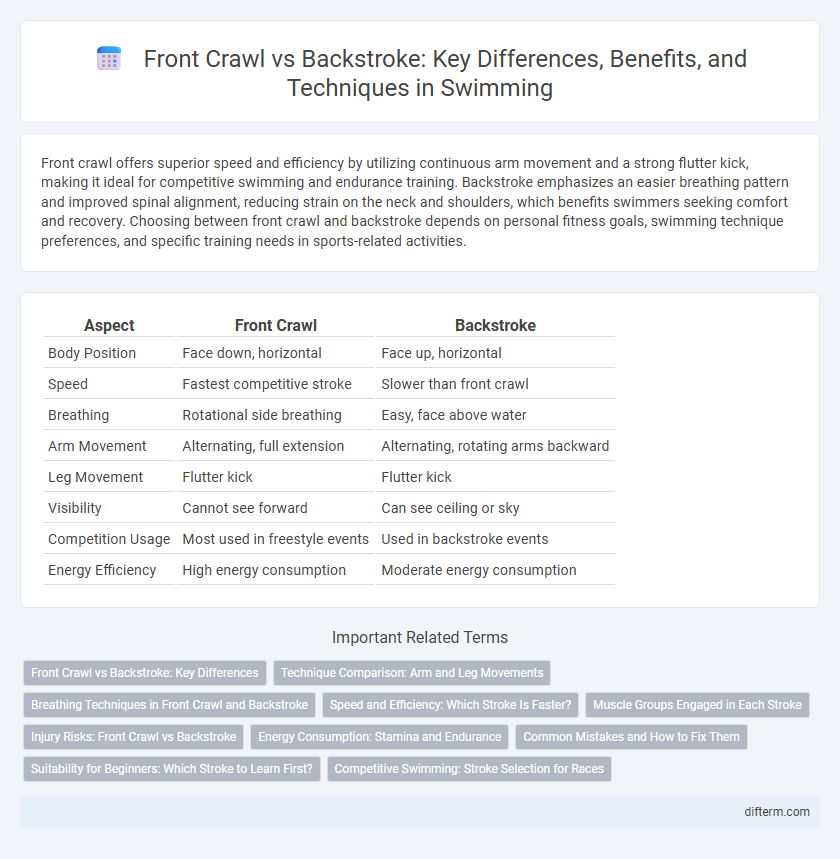Front crawl offers superior speed and efficiency by utilizing continuous arm movement and a strong flutter kick, making it ideal for competitive swimming and endurance training. Backstroke emphasizes an easier breathing pattern and improved spinal alignment, reducing strain on the neck and shoulders, which benefits swimmers seeking comfort and recovery. Choosing between front crawl and backstroke depends on personal fitness goals, swimming technique preferences, and specific training needs in sports-related activities.
Table of Comparison
| Aspect | Front Crawl | Backstroke |
|---|---|---|
| Body Position | Face down, horizontal | Face up, horizontal |
| Speed | Fastest competitive stroke | Slower than front crawl |
| Breathing | Rotational side breathing | Easy, face above water |
| Arm Movement | Alternating, full extension | Alternating, rotating arms backward |
| Leg Movement | Flutter kick | Flutter kick |
| Visibility | Cannot see forward | Can see ceiling or sky |
| Competition Usage | Most used in freestyle events | Used in backstroke events |
| Energy Efficiency | High energy consumption | Moderate energy consumption |
Front Crawl vs Backstroke: Key Differences
Front crawl features a face-down position with alternating arm strokes and flutter kicks, maximizing speed and efficiency in freestyle swimming. Backstroke involves swimming on the back with alternating arm movements and flutter kicks, emphasizing steady breathing and visibility. Key differences include body orientation, breathing technique, and stroke mechanics, influencing competitive strategies and energy expenditure.
Technique Comparison: Arm and Leg Movements
The front crawl features alternating arm strokes with high-elbow recovery and continuous flutter kicking for propulsion and balance. In contrast, backstroke utilizes rotating arm movements with straight arm recovery above the water and a flutter kick that maintains a horizontal body position. Both techniques emphasize core stability and coordinated limb actions to maximize speed and efficiency in the water.
Breathing Techniques in Front Crawl and Backstroke
Breathing techniques in front crawl emphasize rhythmic head rotation to the side, allowing swimmers to inhale quickly without disrupting body alignment, thereby maintaining optimal stroke efficiency. In backstroke, breathing is uninterrupted as the face remains above water, enabling continuous inhalation and exhalation; however, swimmers must control head position to prevent excessive neck strain and maintain streamlined posture. Mastery of these breathing methods enhances oxygen intake, reduces fatigue, and improves overall swimming performance across competitive front crawl and backstroke events.
Speed and Efficiency: Which Stroke Is Faster?
The front crawl is widely recognized as the fastest swimming stroke due to its continuous propulsion and streamlined body position, allowing swimmers to cover distances more quickly. In contrast, the backstroke, while efficient and providing better breathing control, generally results in slower speeds because of less powerful arm pulls and a less hydrodynamic posture. Competitive swimmers often choose the front crawl for speed-focused events, whereas the backstroke is preferred for endurance and breathing ease.
Muscle Groups Engaged in Each Stroke
The front crawl primarily engages the latissimus dorsi, pectoral muscles, deltoids, and triceps for powerful propulsion, while the core muscles stabilize the body during each stroke cycle. In contrast, the backstroke activates the trapezius, rhomboids, and posterior deltoids more intensely, with strong involvement of the lumbar muscles to maintain a streamlined position. Both strokes rely on the quadriceps and hamstrings for effective kick propulsion, but their muscle activation patterns differ due to body positioning and movement mechanics in the water.
Injury Risks: Front Crawl vs Backstroke
The front crawl places significant stress on the shoulders due to repetitive overhead arm movements, increasing the risk of swimmer's shoulder and rotator cuff injuries. In contrast, the backstroke reduces shoulder impingement by promoting a more natural arm rotation but may strain the lower back and neck due to prolonged spinal extension. Proper technique and conditioning are critical in both strokes to minimize injury risks and enhance performance.
Energy Consumption: Stamina and Endurance
Front crawl demands higher energy consumption due to continuous propulsion and increased oxygen intake, enhancing stamina and cardiovascular endurance. Backstroke, while engaging fewer muscle groups intensely, allows for more controlled breathing and moderate energy use, promoting sustainable endurance over longer distances. Swimmers optimizing training often balance both strokes to improve overall stamina and efficient energy utilization in competitive swimming.
Common Mistakes and How to Fix Them
Common mistakes in front crawl include improper breathing technique, crossing the arms over the centerline, and inadequate body rotation, which can lead to inefficient strokes and fatigue. To fix these issues, swimmers should practice bilateral breathing, maintain a straight arm path aligned with the body's midline, and engage core muscles for smooth rotation. In backstroke, common errors involve poor head positioning, excessive arching of the lower back, and uneven arm recovery, which disrupt streamline and increase drag; correcting these requires keeping the head neutral, tightening the core to support spinal alignment, and executing symmetrical arm pulls with relaxed recovery.
Suitability for Beginners: Which Stroke to Learn First?
Front crawl offers a more natural breathing rhythm and streamlined body position, making it easier for beginners to learn and build endurance. Backstroke, while beneficial for improving posture and reducing neck strain, requires good coordination to maintain balance on the back and manage arm rotation. Prioritizing front crawl as the first stroke facilitates quicker skill acquisition and confidence in novice swimmers.
Competitive Swimming: Stroke Selection for Races
Front crawl delivers superior speed and efficiency, making it the preferred stroke in freestyle races and sprint events. Backstroke offers strategic advantages in mid-distance and longer races by allowing continuous breathing and better orientation during turns. Elite swimmers select strokes based on race distance, competition rules, and individual strengths to maximize performance outcomes.
Front crawl vs backstroke Infographic

 difterm.com
difterm.com